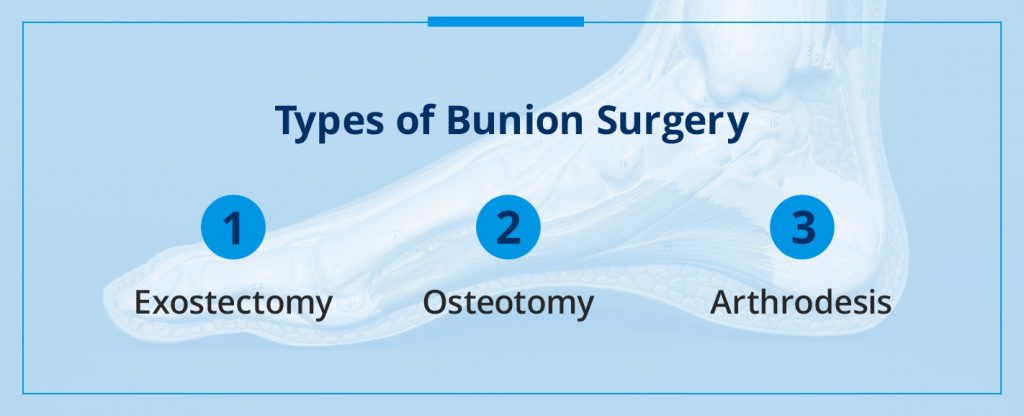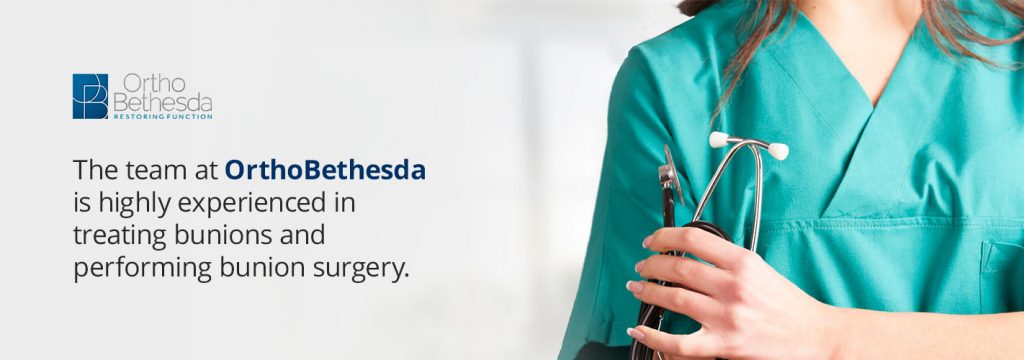
Bunions are one of the most common foot disorders. Some reports indicate that nearly 23% of Americans between the ages of 18 and 65 have bunions, while about 35% of those over 65 do. Different factors can cause a person to develop bunions, including genetics, family medical history, age and lifestyle, among others.
In many cases, bunions are a relatively mild foot disorder that can often be addressed with both at-home remedies and professional medical interventions. Depending on the severity of the bunion, a physician may recommend bunion surgery. There are three main types of bunion surgery, all of which are safe and relatively non-invasive and can greatly improve a patient’s quality of life.
Do you think you may be a candidate for bunion surgery? Learn more about the procedure here before getting in touch with an experienced podiatrist or other medical professional.
What Is a Bunion?
Bunions most commonly form around a person’s big toe. The big toe itself comprises two joints, the larger of which is called the “metatarsophalangeal” (MTP) joint. The MTP joint is located between the foot’s first metatarsal bone and first phalanx bone. When the MTP moves out of alignment — causing the metatarsal and phalanx bones to point inward — it creates the right environment for a bunion to form. Bunions most often develop slowly and occur after prolonged periods of stress and misalignment relating to the MTP joint.

The medical name for a bunion is “hallux valgus.” The term bunion comes from a Greek word meaning “turnip,” as a bunion itself can often have a similar appearance to that of a red, bulbous turnip. The bunion is essentially a type of inflammation around the MTP joint that, over time, can affect the foot’s bone structure. When left untreated, bunions can cause joint aches and pains, inflammation, redness and swelling, stiffness and restricted motion in the toe or foot and even difficulty walking.
When a Doctor May Recommend Bunion Surgery
Some of the most common causes of bunions include lifestyle, family history and underlying health issues — for example, inflammatory conditions such as rheumatoid arthritis or polio. Lifestyle factors that can contribute to bunion development include wearing tight, constricting shoes — especially those with a pointed and narrow toe box — and doing certain activities, like dancing en pointe.
In many cases, especially when they are caught early, bunions can be treated with different home remedies. These remedies can include wearing wide, comfortable shoes or bunion paddings and using orthopedic shoe inserts. Your doctor may also recommend that you ice your bunion daily, which can help reduce inflammation. Over-the-counter NSAID pain relievers, like naproxen and ibuprofen, can also help mitigate bunion discomfort.
If home remedies are not sufficient, your doctor may recommend bunion surgery. A doctor will usually only recommend surgery for your bunions if they cause significant chronic functional issues in your life.
If you experience severe foot pain even when wearing wide, comfortable shoes, if your big toe has drifted significantly toward your smaller toes, if you have foot inflammation that will not go away or if your bunion limits your mobility and causes you chronic pain, bunion surgery may be the right option for you. Of course, only a medical professional can accurately assess your candidacy for surgery.
Types of Bunion Surgery
Each of the following bunion surgical techniques is safe, tested and effective. Consulting with your podiatrist or orthopedic surgeon and considering the exact condition of your bunions and your personal medical history will help you determine a surgery plan that’s right for you. The three most common types of bunion surgery include:
- Exostectomy. An exostectomy, also known as a “bunionectomy,” is a medical procedure in which your surgeon essentially shaves off the bunion. An exostectomy alone does not realign the MTP joint. As such, this procedure is often paired with an osteotomy. An exostectomy is commonly only effective on very small bunions. As such, it is often not the best option for patients with more extreme cases.
- Osteotomy. In contrast with an exostectomy, an osteotomy is a slightly more invasive procedure. In an osteotomy, the surgeon will make several small incisions into the foot’s bones. Then, the surgeon will use small screws or pins to realign the bones and joints that are causing the bunion to form. Osteotomies are the most commonly performed surgical procedure for treating bunions.
- Arthrodesis. In some cases, bunions form because of arthritis-related inflammation. Your surgeon will likely create a treatment plan that considers the additional concerns arthritis can raise. In an arthrodesis procedure, the surgeon will remove any parts of the MTP joint that have arthritis. After removing the joint, the surgeon will insert screws or pins to hold the bones together during the healing process. Due to the invasive and permanent nature of this procedure, it is generally only performed to address the most severe types of bunions.

Myths and Misconceptions About Bunion Surgery
There are several common myths and misconceptions about bunions themselves and bunion surgeries and other treatment options. Understanding and dispelling these myths and misconceptions is important to establish a scientific, evidence-based treatment plan for your bunions and your overall foot health and mobility. Some of the most common misconceptions about bunions and bunion surgery include the following:
Bunions Can Be Reversed Without Surgery
This is one of the most pervasive myths about bunions. Once your MTP joint becomes misaligned, it is virtually impossible to realign it without surgical intervention. However, that’s not to say all bunions need to be addressed with surgery. Many people with bunions find them merely annoying more than anything else, and do not experience enough pain, inflammation or mobility issues to pursue surgery.
Many people who suffer from minor bunion issues can easily manage them with home treatments. These home treatments can relieve bunion pain, but it is important to understand that home remedies will not reverse bunions. Only surgery can reverse — or more accurately, remove — bunions.
Wearing High Heels Causes Bunions
Another highly pervasive myth about bunions is that they are caused by wearing high heels. You will often see this myth cited around the internet, and many people blame high heels as the reason women develop bunions more frequently than men. However, this is a misleading idea. High heels or tight-fitting shoes alone cannot cause bunions. Bunions develop due to a combination of factors — the most influential of which are the person’s genetics, family medical history and underlying medical conditions.

For example, a woman who has an inflammatory condition or a family history of bunions is much more likely to develop them than a woman who does not have a genetic predisposition for bunions. This is regardless of how often each woman may or may not wear high heels.
However, high heels and other tight or ill-fitting shoes can exacerbate bunions and may contribute to their development over a long period. For patients who already have bunions, avoiding high heels can help minimize inflammation and joint pain.
Bunion Surgery Is Extremely Painful
Many people fear undergoing bunion surgery out of concern that it is overly dangerous and very painful. Many patients may have heard horror stories and worst-case-scenarios about bunion removals and other surgical procedures. While any type of surgery comes with some risks, bunion surgeries are safe, evidence-based procedures with years of proven, effective results.
Bunion surgeries are typically quick outpatient procedures that do not require hospital stays. Thanks to modern anesthesia and pain relief medications, you should not experience any acute pain during or after the surgery. Some aches and discomforts can be expected during the recovery process — your doctor will help you navigate any post-op pain.
If your bunion is serious enough to warrant surgical intervention, the discomfort and post-op recovery time will likely be well worth it in the long run. As always, discuss any fears and reservations you may have with your physician and surgical team. Pre- and post-surgery planning is key to reducing stress and fear around the entire experience.
Potential Risks of Bunion Surgery
As is true with any type of medical procedure, there are naturally some risks associated with bunion surgery. Whether you are a good candidate for bunion surgery and which type of surgery is right for you is something to discuss with your podiatrist, orthopedic surgeon or another trusted medical professional. When bunion surgery is successful, you can expect to have less foot pain, less inflammation, more mobility and an increase in your overall quality of life.
It’s important to be aware of the potential risks of bunion surgery. However, keep in mind that no one person’s surgical experience can necessarily inform another’s. Everyone’s experience depends on their unique medical situation and predispositions. If you are anxious or fearful about potential surgical risks, discuss any present concerns with your doctor.
Some of the most common risks of bunion surgery include the following:
Bunion Recurrence
Because bunions are most often caused by genetic, hereditary factors and underlying health conditions, the chance for recurrence is always a possibility. Due to the complexity of factors involved, it is nearly impossible to share cut-and-dried statistics about bunion recurrence that apply to all patients. However, recurrence is still possible.
Some reports indicate that bunion recurrence is most likely to happen when the initial surgery does not adequately address the severity of the bunion and when the bunion’s angle is 20 degrees or larger. A study from The Journal of Bone & Joint Surgery noted that bunions were 28 times more likely to reappear in patients who had a hallux valgus angle (HVA) of eight degrees or more after surgery.
Even when recurrence does happen, it generally occurs over a very long period. As such, a patient can expect to enjoy a bunion-free life for some time, even if their bunion does eventually reoccur. The risk of bunion recurrence can often be avoided simply by entrusting your surgery to a highly experienced expert foot surgeon.

Joint Stiffness
Scar tissue is an unfortunate side effect of nearly all types of surgical interventions, and bunion surgeries are no exception to this. In some cases, scar tissue can build up inside the MTP joint. If this occurs, the patient may experience some soreness in the joint. In severe instances, this joint stiffness can be uncomfortable and may affect mobility in the big toe around where the bunion was removed.
Mobility issues generally only occur when the bunion was present for many, many years. When the MTP joint is misaligned for so long, sometimes even surgery cannot fully restore motion in the big toe. If arthritis was an underlying factor before the bunion removal, it may cause additional joint stiffness after surgery as well. Joint stiffness can usually be avoided or mitigated by physical therapy, massages and other interventions.
Infection
Surgery, by nature, requires introducing foreign objects into a patient’s body. As such, infection is always a potential risk. With bunion surgery, infection is highly uncommon, though it can become serious when left untreated. In most situations, bunion surgery infections are limited to superficial skin infections that can be easily treated. Most modern physicians have access to antibiotics, making the prevention and treatment of infections relatively straightforward.
The patient often receives intravenous antibiotics pre-surgery, and surgeons will often cleanse the foot in antiseptic before they begin. However, the best way to avoid infection is to maintain a healthy immune system and overall healthy lifestyle before undergoing bunion surgery — or surgery of any kind. Maintain a balanced diet, get lots of rest and keep your stress low prior to surgery, and allow yourself time to heal post-surgery. Looking after your overall health can go a long way in preventing infection.

Bone Healing Issues
Bunion surgery often requires the surgeon to cut into parts of the patient’s foot bone, and it may also involve fusing bones together. As such, the postoperative healing timeline can be quite long. Bunion surgery recovery time can vary. On average, it takes about six to eight weeks for full bone healing to occur. In some very rare cases, the bones simply do not heal. When this occurs, it is called “nonunion.”
Redness, swelling and inflammation can sometimes be signs of nonunion. Nonunion typically occurs when the patient has underlying health conditions or does not maintain a healthy lifestyle. Nicotine, in particular, has been linked to nonunion and other general bone healing issues. Patients should avoid smoking and contact with other smokers during their recovery process.
The Benefits of Bunion Surgery
It’s natural to feel anxious about the prospect of bunion surgery. While it is critical to understand the potential risks associated with the surgery, you should also consider the many benefits of the procedure. Living with a bunion can be uncomfortable and sometimes really painful. The appearance of your bunion may also affect your confidence and self-esteem. Bunion surgery can often mitigate or eliminate these issues for patients, creating a happier lifestyle and healthier quality of life.

Some of the most common benefits of bunion surgery include:
Pain Relief
Many people who suffer from bunions experience some level of pain. This can vary from mild discomfort to chronic, severe pain. At its worst, the pain associated with bunions can truly impede a patient’s mobility and overall quality of life. After a successful bunion surgery, patients can expect to have nearly all their bunion-related pain eliminated.
Fully resting and healing post-op and doing consistent physical therapy if recommended can further contribute to the extent of pain relief that bunion surgery can provide. Most bunion surgery patients report that having the surgery greatly contributes to their long-term comfort and pain relief.
Effectiveness and Efficiency
Many people who suffer from bunions are likely familiar with various common home remedies and other interventions that claim to “cure” or otherwise resolve bunions. Some home remedies, like icing inflammation and wearing well-fitting, comfortable shoes, can alleviate bunion-related pain and mobility issues. However, there is no scientific evidence to indicate any home remedies can heal bunions permanently.
For patients who are interested in resolving their bunion issues in the most effective and efficient way, surgery is the best-proven option. Entrusting your surgery to an experienced surgeon is also key to getting the best results from your bunion removal.

Increased Mobility
Many people who suffer from bunions and bunion-related pain and discomfort find daily activities cumbersome. For some, bunions cause so much pain that individuals may even avoid walking and exercising altogether. However, remaining sedentary is not advantageous for a person’s overall health. Consequently, if a bunion is preventing you from being active and mobile, it can potentially negatively impact your overall health. In that case, bunion removal can restore you to greater mobility and increase your capacity to live a pain-free, active life.
Recovering From Bunion Surgery
Each patient is different and will have a unique surgery and postoperative treatment plan. As such, you shouldn’t compare your experience or recovery timeline to others who likely have different characteristics from you — such as genetic traits or lifestyle habits. However, there are some common principles to keep in mind when preparing for your life immediately post-surgery.
Your surgeon or another healthcare provider will give you detailed instructions for taking care of yourself and your foot after your bunion surgery. Common instructions include some or all of the following tips:

- Keep your foot elevated. You can use pillows or cushions to keep your foot elevated. Elevation can help reduce pain and swelling around the surgical site.
- Apply ice. Similar to using elevation, applying ice or a bag of frozen vegetables on top of the surgical site can also help reduce swelling. Ice can also aid in alleviating pain and discomfort.
- Avoid walking. Surgeons will nearly always instruct their patients to avoid walking or putting any type of pressure on the foot immediately after surgery. You may be instructed to use a wheelchair or cane as needed.
- Keep your foot dressing clean and dry. Keeping your surgical dressing clean and dry is key to preventing infection and ensuring the wound heals quickly and correctly. Wrap your dressing in plastic while bathing. Stitches are generally removed about two weeks post-op, at which point your doctor will evaluate your wound and see how it is healing.
When Bunion Surgery Is Worth It
Now that you know the ins and outs of bunion surgery, you can more easily put your concerns to rest and begin seeking medical help. The team at OrthoBethesda is highly experienced in treating bunions and performing bunion surgery. Each of our board-certified physicians is skilled in orthopedic medicine and committed to the health and well-being of our patients. With over 50 years of proven experience treating a range of different orthopedic issues, our practice has established itself as a leader in orthopedic care in the DMV region.
OrthoBethesda is proud to serve the communities of Bethesda, MD, Arlington, VA, and other surrounding areas. Contact the office today for an initial consultation. Our team is ready to help you live your best life!


